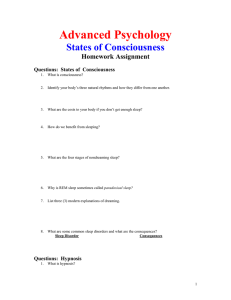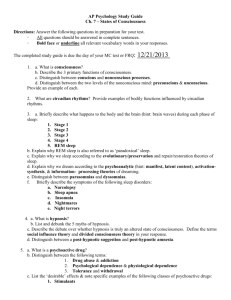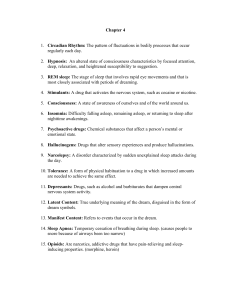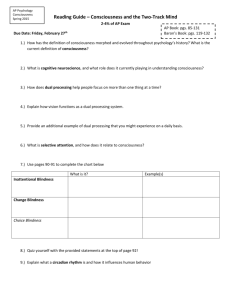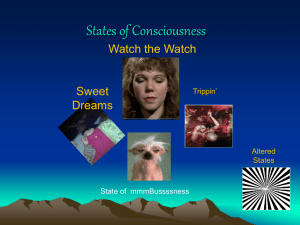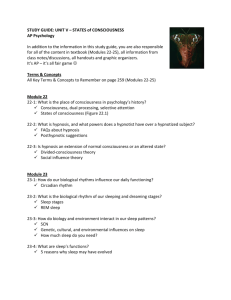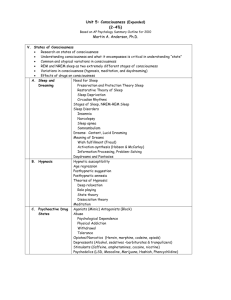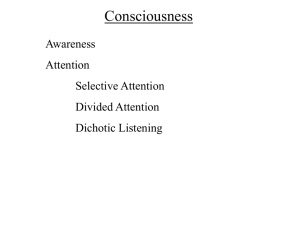Chapter 9 LEARNING OBJECTIVES 1. Define consciousness. (p
advertisement
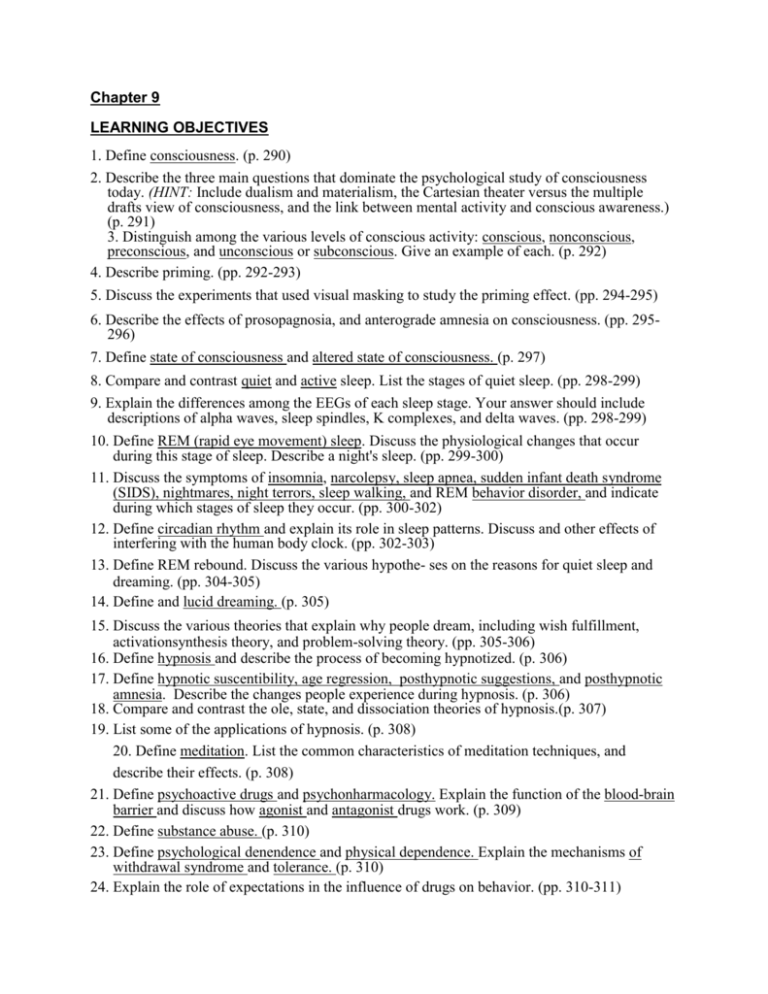
Chapter 9 LEARNING OBJECTIVES 1. Define consciousness. (p. 290) 2. Describe the three main questions that dominate the psychological study of consciousness today. (HINT: Include dualism and materialism, the Cartesian theater versus the multiple drafts view of consciousness, and the link between mental activity and conscious awareness.) (p. 291) 3. Distinguish among the various levels of conscious activity: conscious, nonconscious, preconscious, and unconscious or subconscious. Give an example of each. (p. 292) 4. Describe priming. (pp. 292-293) 5. Discuss the experiments that used visual masking to study the priming effect. (pp. 294-295) 6. Describe the effects of prosopagnosia, and anterograde amnesia on consciousness. (pp. 295296) 7. Define state of consciousness and altered state of consciousness. (p. 297) 8. Compare and contrast quiet and active sleep. List the stages of quiet sleep. (pp. 298-299) 9. Explain the differences among the EEGs of each sleep stage. Your answer should include descriptions of alpha waves, sleep spindles, K complexes, and delta waves. (pp. 298-299) 10. Define REM (rapid eye movement) sleep. Discuss the physiological changes that occur during this stage of sleep. Describe a night's sleep. (pp. 299-300) 11. Discuss the symptoms of insomnia, narcolepsy, sleep apnea, sudden infant death syndrome (SIDS), nightmares, night terrors, sleep walking, and REM behavior disorder, and indicate during which stages of sleep they occur. (pp. 300-302) 12. Define circadian rhythm and explain its role in sleep patterns. Discuss and other effects of interfering with the human body clock. (pp. 302-303) 13. Define REM rebound. Discuss the various hypothe- ses on the reasons for quiet sleep and dreaming. (pp. 304-305) 14. Define and lucid dreaming. (p. 305) 15. Discuss the various theories that explain why people dream, including wish fulfillment, activationsynthesis theory, and problem-solving theory. (pp. 305-306) 16. Define hypnosis and describe the process of becoming hypnotized. (p. 306) 17. Define hypnotic suscentibility, age regression, posthypnotic suggestions, and posthypnotic amnesia. Describe the changes people experience during hypnosis. (p. 306) 18. Compare and contrast the ole, state, and dissociation theories of hypnosis.(p. 307) 19. List some of the applications of hypnosis. (p. 308) 20. Define meditation. List the common characteristics of meditation techniques, and describe their effects. (p. 308) 21. Define psychoactive drugs and psychonharmacology. Explain the function of the blood-brain barrier and discuss how agonist and antagonist drugs work. (p. 309) 22. Define substance abuse. (p. 310) 23. Define psychological denendence and physical dependence. Explain the mechanisms of withdrawal syndrome and tolerance. (p. 310) 24. Explain the role of expectations in the influence of drugs on behavior. (pp. 310-311) 25. Define depressant. Describe the effects of alcohol and barbiturates on the nervous system and behavior. (pp. 311-313) 26. Define stimulant. Describe the effects of amphetamines, cocaine, caffeine, nicotine, and MDMA on the nervous system and behavior. (pp. 313-314) 27. Define opiates. Describe the effects of opium, morphine, codeine, and heroin on the nervous system. (p.315) 28. Define phychedelic. Describe the effects of LSD and marijuana on the nervous system and behavior . (pp.315-316)

